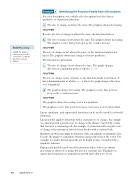Page 827 - Algebra 1
P. 827
Example
3
Identifying the Function Family from a Description
For each description, state whether the description best fits a linear, quadratic, or exponential function.
a. The rate of change is always the same. The graph is always decreasing. SOLUTION
Because the rate of change is always the same, the function is linear.
b. The rate of change is not always the same. The graph is always increasing. The graph is a curve that gets steeper as the x-values increase.
SOLUTION
The rate of change is not always the same, so the function family is not linear. The graph is always increasing, so it is not quadratic.
The function is exponential.
c. The rate of change is not always the same. The graph changes
direction at a minimum point at which y = -1. SOLUTION
The rate of change is not constant, so the function family is not linear. It has a minimum point at which y = -1 where the graph changes direction, so it is quadratic.
d. The graph is always decreasing. The graph is a curve that gets less steep as the x-values increase.
SOLUTION
The graph is always decreasing, so it is not quadratic.
The graph is a curve that gets less steep as x increases, so it is exponential.
Linear, quadratic, and exponential functions can be used to model real-world situations.
Linear models apply to situations with a constant rate of change. An example of a function with a positive rate of change is the distance traveled by a train that travels at a constant speed. An example of a function with a negative rate of change is the amount of water left in a bucket with a constant leak.
Quadratic models may apply in situations with a maximum or minimum value because the graph of a quadratic function changes direction at the vertex. For example, if a ball is thrown up in the air, its height at time t is modeled by a quadratic function.
Exponential models can be used for situations where values are always increasing or always decreasing, but not at a constant rate. Examples of exponential situations are population growth and radioactive decay.
Math Reasoning
Justify The graph of
a function crosses the x-axis twice. Could the function be linear? Explain.
812 Saxon Algebra 1


